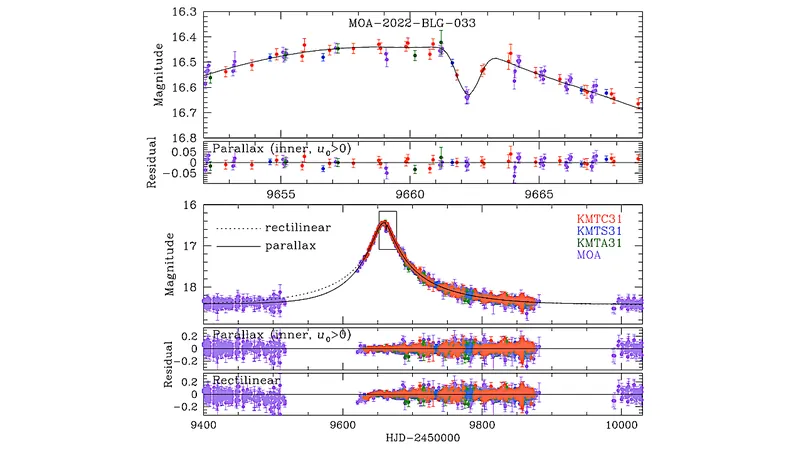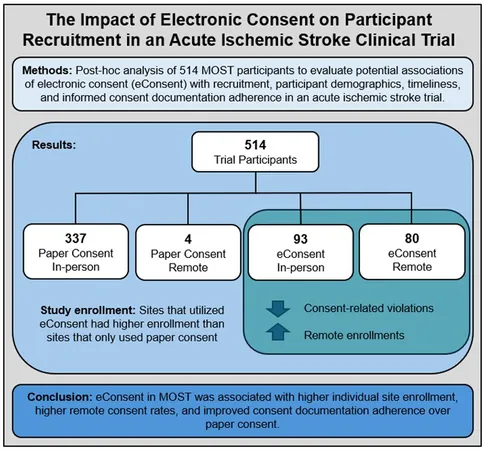
Exciting Discovery: New Microlensing Planets Found with Unprecedented Low Mass Ratios!
2025-01-18
Author: Wei
Introduction
In a groundbreaking study, astronomers have delved into anomalies seen in the light curves of several microlensing events—specifically MOA-2022-BLG-033, KMT-2023-BLG-0119, and KMT-2023-BLG-1896. These investigations revealed that the peculiar signals observed during these lensing events are attributable to planetary companions orbiting the primary lens stars, which is an exciting revelation for the field of exoplanet research.
Planet-to-Host Mass Ratios
The analysis highlighted strikingly low planet-to-host mass ratios, revealing q ≈ 7.5 × 10⁻⁵ for MOA-2022-BLG-033, q ≈ 3.6 × 10⁻⁴ for KMT-2023-BLG-0119, and q ≈ 6.9 × 10⁻⁵ for KMT-2023-BLG-1896. These ratios suggest that these planets are relatively lightweight compared to their host stars, raising intriguing questions about the formation and evolution of such systems.
Anomaly Analysis
The anomalies occurred specifically when the source star crossed through a negative deviation region behind the central caustic along the axis connecting the planet and its host star. Interestingly, consultation of a common inner-outer degeneracy has caused fluctuations in the projected planet-host separation measurements. For instance, while KMT-2023-BLG-1896 strongly favors a planetary model to explain the anomaly, it remains marginally possible that a binary companion scenario could fit the observations.
Bayesian Analysis Insights
Further insights into the composition and characteristics of these planetary systems were drawn from Bayesian analyses utilizing the lensing observables. The findings indicate that MOA-2022-BLG-033L contains an ice giant approximately 12 times the mass of Earth, orbiting a type of star classified as an early M dwarf. Additionally, KMT-2023-BLG-1896L hosts another ice giant, this one around 16 Earth masses, revolving around a mid-K-type main-sequence star. KMT-2023-BLG-0119L presents a Saturn-like companion, situated around a mid-K-type dwarf star.
Location of Lenses
The location of the lenses also reveals intriguing aspects of these systems—while MOA-2022-BLG-033's lens is highly likely to be in the galactic disk, the likelihood of the lenses in the other events being situated in either the disk or the galactic bulge remains roughly equal.
Conclusion
This innovative research has led to the identification of three noteworthy low mass-ratio microlensing planets: MOA-2022-BLG-033Lb, KMT-2023-BLG-0119Lb, and KMT-2023-BLG-1896Lb. As we continue to uncover the mysteries of the universe, these discoveries hold exciting potential for future astronomical studies and the ongoing search for exoplanets that may harbor life.
Stay tuned as researchers aim to further refine our understanding of these celestial findings, shedding light on the diverse and complex nature of planetary systems throughout the cosmos!



 Brasil (PT)
Brasil (PT)
 Canada (EN)
Canada (EN)
 Chile (ES)
Chile (ES)
 Česko (CS)
Česko (CS)
 대한민국 (KO)
대한민국 (KO)
 España (ES)
España (ES)
 France (FR)
France (FR)
 Hong Kong (EN)
Hong Kong (EN)
 Italia (IT)
Italia (IT)
 日本 (JA)
日本 (JA)
 Magyarország (HU)
Magyarország (HU)
 Norge (NO)
Norge (NO)
 Polska (PL)
Polska (PL)
 Schweiz (DE)
Schweiz (DE)
 Singapore (EN)
Singapore (EN)
 Sverige (SV)
Sverige (SV)
 Suomi (FI)
Suomi (FI)
 Türkiye (TR)
Türkiye (TR)
 الإمارات العربية المتحدة (AR)
الإمارات العربية المتحدة (AR)